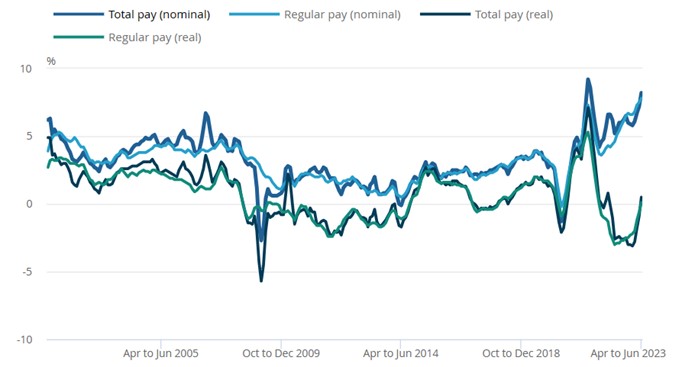ONS Labour Market August 2023
Thirteenth consecutive quarterly fall in vacancies
- The number of job vacancies in May to July 2023 was 1,020,000 - a decrease of 66,000 from February to April 2023.
- The largest falls in vacancies came from professional, scientific and technical activities, and administrative and support services which decreased by 13.2% and 12.7% respectively.
- Real estate activities, and electricity, gas, steam and air conditioning supply saw strong quarterly growth in vacancies, with increases of 17.4% and 11.9% respectively.
- On an annual basis, total vacancies decreased by 256,000, with accommodation and food service activities, and professional, scientific and technical activities experiencing the largest falls.
- The total number of vacancies remained 219,000 above pre-pandemic levels (January to March 2020).
Fall in retail employees
Fall in retail employees
- Early payroll estimates for July show the number of payrolled employees rose by 578,000 employees compared to the previous year (up 1.9%).
- On the previous month, the number of payrolled employees increased by 97,000, or 0.3%.
- The largest yearly increase in payrolled employees continued to be driven by health and social work sector (a rise of 214,000 employees YoY), while the smallest was in the wholesale and retail sector (a fall of 10,000).
Inactivity decreases
- The unemployment rate for April to June 2023 is estimated at 4.2%, 0.3pp higher than the previous three-month period and 0.2pp above pre-pandemic levels. I
- In the quarter, the number of people unemployed for up to six months increased, while those unemployed for over twelve months decreased.
- The economic inactivity rate decreased by 0.1pp on the quarter to 20.9% in April to June. Although declining, inactivity is 0.2pp above the pre-pandemic level.
Employment rate falls
- The employment rate for April to June fell 0.1pp in the quarter to 75.7% and is 0.8pp below pre-pandemic levels.
- The number of full-time employees decreased in the period but remains above pre-pandemic levels. The number of part-time employees also increased in the quarter.
Hours worked increases
- Total actual weekly hours worked decreased by 5.6 million hours on the quarter to 1.05 billion hours in April to June.
- This is 5.8 million hours below pre-pandemic levels (December 2019 to February 2020).
- The decrease in the quarter was driven by both men and women.
Real earnings edge up
- In nominal terms, average regular pay (excluding bonuses) for employees in Great Britain was £613 per week before tax and other deductions from pay in June – up from £568 per week a year earlier.
- Average total pay (including bonuses) for employees in Great Britain was £663 per week before tax and other deductions from pay in June – up from £610 per week a year earlier.
- Regular pay rose by 7.8% and total pay by 8.2% in the three months to June compared to a year earlier.
- Average regular pay growth in the private sector was 8.2% in the three months to June, while public sector pay rose by 6.2%.
- In real terms (adjusted for inflation), regular pay and total pay increased 0.1% and 0.5% YoY respectively in the three months to June.
Average weekly earnings annual growth rates in Great Britain, seasonally adjusted, January to March 2001 to April to June 2023

Source: ONS
Back to Retail Economic News